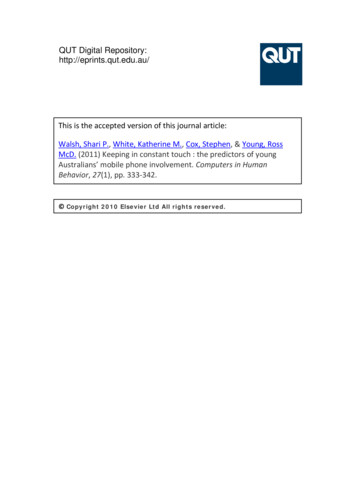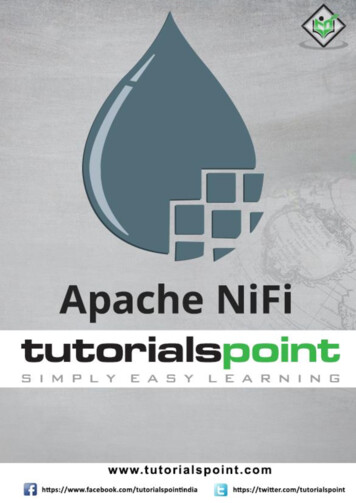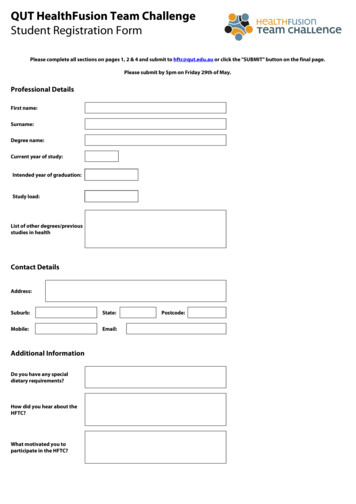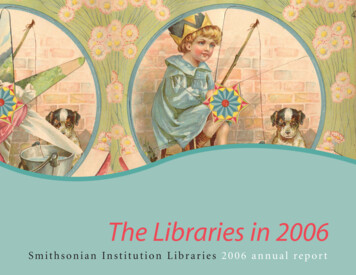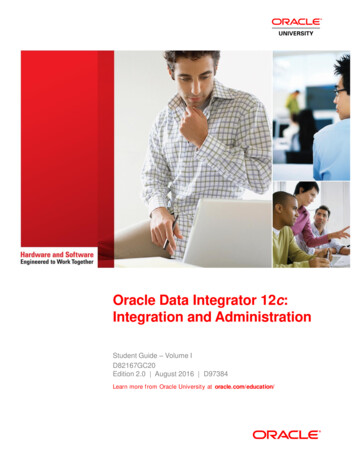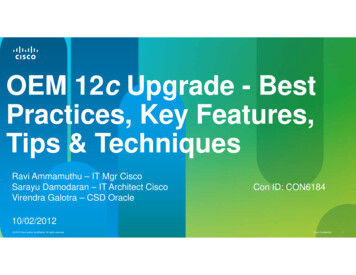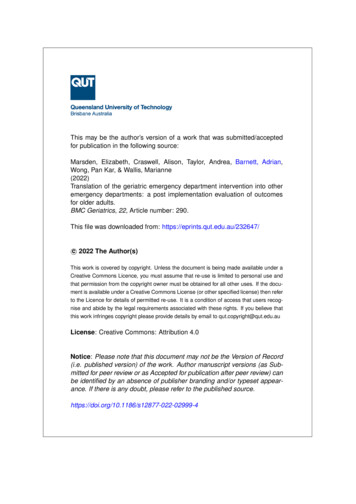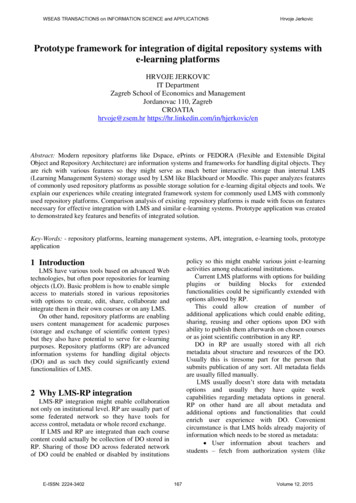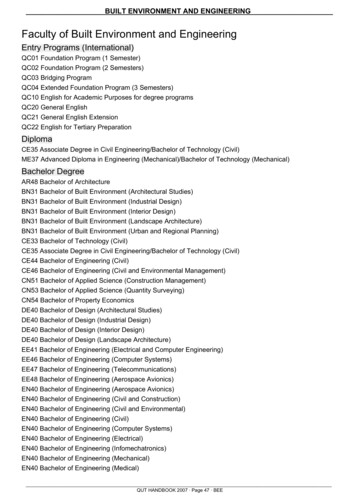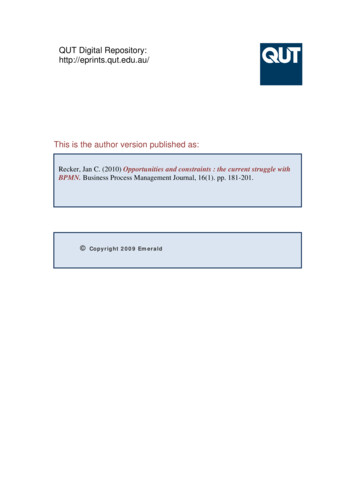
Transcription
QUT Digital Repository:http://eprints.qut.edu.au/This is the author version published as:This is the accepted version of this article. To be published as :This is the author version published as:Recker, Jan C. (2010) Opportunities and constraints : the current struggle withBPMN. Business Process Management Journal, 16(1). pp. 181-201. Copyright 2009 Emerald
Opportunities and Constraints:The Current Struggle with BPMNAbstractPurpose – The Business Process Modeling Notation is an increasingly importantstandard for process modeling and has enjoyed high levels of attention in businesspractice. In this paper, experiences are shared from several research projects investigatingthe uptake and user acceptance of BPMN by analysts world-wide. This personalviewpoint offers a number of implications for BPM practice and seeks to stimulate andguide further research and other developments in this area.Design/methodology/approach – This article offers a personal viewpoint based on theexperiences and findings gathered from survey research and interviews on the use ofBPMN. While details on research execution are mostly omitted, references are providedto guide the interested reader to the methodology used in the original studies.Findings – First, statistics are provided on the usage of BPMN by process modelersworld-wide. Amongst others, it is shown that the high interest in BPMN has created amassive demand for BPM education and training. Second, a number of usage problemsrelated to the practice of process modeling with BPMN are described and suggestions areprovided how organizations have developed workarounds for these problems. Third, it issuggested that BPMN is over-engineered and more insights into practical usage areneeded for future development.Research limitations / implications – While being based on empirical research, alimitation of this paper is the lack of detail about research execution; however, referencesare provided. The paper offers a personal viewpoint on the state of current and futurepractice of process modeling and discusses a range of implications for future research.Practical implications – The paper describes a number of commonly encounteredpitfalls when modeling processes with BPMN. It also provides directions for theorganizational implementation and future development of process modeling as well asimplications for various BPMN stakeholders.Originality/value – This viewpoint is derived from some of very few empirical studieson the usage of BPMN specifically and BPM standards generally.Keywords – Process modeling, standards, surveyPaper type – ViewpointPage 1/23
1. IntroductionSince the first lines were scratched into the dirt, people have been drawing pictures tohelp them explain things. People understand graphics – be it as part of Google Earth, intheir Tom Toms, in software development projects, or in the management of businessprocesses. The graphical specification of business operations and transactions in the formof so-called process models is an important tool in the design, re-design, enactment andevaluation of business activities and regularly consumes a considerable amount ofresources and time in process management projects (Indulska et al., 2006).A large number of graphical process modeling languages has been developed to aidorganizations in the documentation of their processes. These languages range fromsimple flowcharting techniques to more advanced languages capable of capturinginformation required for process simulation and execution. The latest representative fromthe large camp of process modeling languages has become known under the acronymBPMN – the Business Process Modeling Notation (BPMI.org and OMG, 2006). BPMNis a recently published notation standard for business processes. It was developed by anindustry consortium (BPMI.org), whose constituents represented a wide range of BPMtool vendors but no end users. Although the ‘official’ release date was only February2006, BPMN has quickly become a de facto standard for graphical process modeling. Noother notation has seen such an uptake in such a short time as BPMN has. It is widelysupported by both free and commercial process modeling tools (e.g., Pega, Sparxsystems,Telelogic, Intalio, itp-commerce, Tibco, IBM Websphere, Sungard), integrated into thecurriculum of education providers (e.g., Widener University, Queensland University ofTechnology and Howe School of Technology Management), and part of the offerings ofmodeling coaches and consultants (e.g., Object Training, BPM-Training.com andBPMInstitute.org). Even other standardization bodies (e.g., WfMC) have revised theirstandard development efforts to incorporate BPMN (Workflow Management Coalition,2008).In light of this development, both for scholars studying the phenomenon of BPMN andfor the wider community of BPM practitioners, three questions emerge that wait to beanswered (Zur Muehlen, 2008b):1. How can BPMN be used (i.e., what is theoretically possible)?2. How should BPMN be used (i.e., what is recommended for practice)?3. How is BPMN being used (i.e., what do people actually do with it)?A growing body of research has been conducted – and continues to do so – on questionsone and two. For instance, research has been published that examines BPMN’s capacityto support workflow technology and domain representations (Recker et al., 2007b), tofacilitate semantic script analysis (Dijkman et al., 2008), and how to generate processPage 2/23
(Ouyang et al., 2008a) and software code (Ouyang et al., 2008b) from BPMN. Thefundamental question of how BPMN is actually being used, however, has not yet beenfully examined. In fact, only a few studies have recently been published that begin toshed light into actual application and usage patterns concerning BPMN, mostly in theform of case studies (e.g., Recker et al., 2007a, Recker et al., 2006a, zur Muehlen and Ho,2008). There is research on the uptake and use of standards in related areas, such as thework on the adoption of UML in systems development (Dobing and Parsons, 2006,Kobryn, 1999, Siau and Loo, 2006); however it remains unclear how many of theseinsights apply to the BPM context.The purpose in writing this paper is three-fold. First, to provide results from one of thevery few large-scale studies of BPMN adopters and to deliver insights in the way BPMNis being implemented and used in business practice. Second, based on the experiencesgathered in our research on the BPMN uptake over the last three years, to raise a numberof implications and questions about the current and future state of research and practice inprocess modeling. Third, to stimulate future debate and discussion in the processmodeling ecosystem of vendors, standardization bodies and end users.We proceed as follows. The next section briefly introduces process modeling with BPMNand recapitulates the background of the research studies on the basis of which thisviewpoint was crafted. Section three describes selected results from a global survey ofBPMN adopters conducted in 2007. Section four discusses a number of BPMN usageproblems uncovered during our studies. Section five concludes this viewpoint article andsuggests a number of pathways for practice, future development, and research in the areaof BPMN.2. BackgroundA) Process Modeling with BPMNProcess modeling is widely used within organizations as a method to increase awarenessand knowledge of business processes, and to deconstruct organizational complexity(Bandara et al., 2005). Process models describe how businesses conduct their operationsand typically includes graphical depictions of at least the activities, events/states, andcontrol flow logic that constitute a business process (Curtis et al., 1992). Additionally,process models may also include information regarding the involved data,organizational/IT resources and potentially other artifacts such as external stakeholdersand performance metrics to name just a few (e.g., Scheer, 2000).Process models are designed using so-called process modeling languages (sometimescalled notations or techniques), i.e., sets of graphical constructs and rules how to combinethese constructs. Existing business process modeling languages fall into two categories(Phalp, 1998). Intuitive graphical modeling languages such as the Event-driven ProcessChain (EPC) (Scheer, 2000) are mostly concerned with capturing and understandingprocesses for project scoping tasks, and for discussing business requirements and processimprovement initiatives with subject matter experts. Conversely, other languages such asPetri nets (Petri, 1962) are founded on mathematical, rigorous paradigms. ThesePage 3/23
techniques are typically used for process analysis (Verbeek et al., 2007) or processexecution (van der Aalst and ter Hofstede, 2005), and can also facilitate simulation orexperimentation with process scenarios (Hansen, 1996).In considering ‘how to’ model business processes, the decision of the type of language tobe used for process modeling is an important consideration (Rosemann, 2006). Thisdecision can be seen as essentially the same problem that software engineers encounterwhen carrying out analysis or design tasks. One might choose to use structured analysisnotations, or object-oriented approaches. Different modeling languages tend to emphasizediverse aspects of processes, such as activity sequencing, resource allocation,communications, or organizational responsibilities (Soffer and Wand, 2007). In otherwords, the Petri net model of a business domain looks considerably different from a dataflow diagram or BPMN model of the same domain.A wide range of process modeling languages has been proposed over time, which –recently – has injected a call for standardization efforts in this field (Davenport, 2005).The development of the Business Process Modeling Notation (BPMN) (BPMI.org andOMG, 2006) denotes the answer to this call for standardization. BPMN was developed byan industry consortium, whose constituents represented a wide range of BPM tool vendorsthat envisaged BPMN to be used in many application areas. These areas span typicalprocess documentation and improvement scenarios to technical applications of processmodeling such as workflow engineering, simulation or web service composition.The standardization process took six years and more than 140 meetings, both physicaland virtual. The BPMN working group developed a specification document thatdifferentiates BPMN into a set of core graphical elements and an extended specializedset. The core set was envisage to suffice for depicting the essence of business processesin intuitive graphical models, while the complete set provides additional constructs tosupport advanced process modeling concepts such as process orchestration andchoreography, workflow specification, event-based decision making and exceptionhandling. Overall, the complete BPMN specification defines 53 constructs plus attributes,grouped into four basic categories of elements, viz., Flow Objects, Connecting Objects,Swimlanes and Artefacts. Flow Objects, such as events, activities and gateways, are themost basic elements used to create BPMN models. Connecting Objects are used to interconnect Flow Objects through different types of arrows. Swimlanes are used to groupactivities into separate categories for different functional capabilities or responsibilities(e.g., different roles or organizational departments). Artefacts may be added to a modelwhere appropriate in order to display further related information such as processed dataor other comments. For further information on BPMN refer to (BPMI.org and OMG,2006). Figure 1 gives the example of a BPMN model of a payment process.Page 4/23
DistributionPreparePackage forCustomerRetailerA Start EventA TaskAccept Cashor CheckSalesCheck or CashIdentifyPaymentMethodAuthorizeCredit CardProcessCredit CardResponseRequestFinancial InstitutionAn IntermediateEventA Gateway“Decision”A Sequence FlowCredit CardDeliverPackage toCustomerA MessageAuthorizePaymentAn End EventFigure 1. BPMN example ‘Payment process’B) Data Sources and Study BackgroundThis article offers a viewpoint on the current state and future development of BPMNprocess modeling practice. In doing so, it consolidated experiences and lessons learnedfrom a number of studies we conducted over the last three years on the uptake and usageof BPMN in process modeling practice.Our original motivation to undertake research on the uptake and use of BPMN was basedon the observation that organizations seeking to adopt BPMN were actually shorthandedin terms of experience reports available. Available tutorials were scarce, trainingprograms virtually non-existent and case studies rare. None of these barriers, however,stopped BPMN from its rapid adoption in business practice. The swiftness of this uptake,in turn, motivated us to study the factors explaining adoption, acceptance and use ofprocess modeling in general, and BPMN in particular. More specifically, in our researchwe investigated three aspects of BPMN:-What are capabilities and deficiencies of BPMN for process modeling practice?-Which factors explain the user acceptance of BPMN?-How is BPMN used in practice?To that end, over the last three years we launched three programs of research, using threedifferent types of data collection. First, we performed an analysis of the capabilities anddeficiencies of BPMN using a theory of representation (Wand and Weber, 1990, 1993,1995) This theoretical model allows research to gauge, and compare, the expressivenessand complexity of process modeling language based on an analysis of theirPage 5/23
representational capabilities. This mode of investigation is known as a representationalanalysis and is a widely used tool in research on process modeling (e.g., Green andRosemann, 2000, Green et al., 2005, Recker and Indulska, 2007, Rosemann et al., 2009,Rosemann et al., 2006). Based on our theoretical analysis, we then conducted a range ofsemi-structured interviews with BPMN adopters to study how deficiencies BPMN wereexperienced in process modeling practice and how BPMN users implemented workarounds to mitigate these deficiencies. This type of study can be classified as anexploratory, qualitative theory-driven investigation (Benbasat et al., 1987) using semistructured interviews as a research method and following the guidelines for qualitativecase study and interview research as described in (Yin, 2003) and (Kvale, 1996, Myersand Newman, 2007). In our study, six Australian-based organizations participated asresearch cases, and a total of nineteen practitioners of these six organizations,incorporating various roles in their respective business environments, (e.g., businessanalyst, technical analyst, modeling team leader), were interviewed. The participantsranged in terms of their levels of experience with modeling, and with BPMN. In depthdetails about design, conduct, and results of this study are available in (Recker et al.,2007a, Recker et al., 2005, 2006a, Recker et al., 2007b).Second, incorporating the findings from our exploratory study, we studied the factorsexplaining continued user acceptance of BPMN by developing a theoretical model of thefactors influencing the continued usage intention (see Recker, 2007, Recker andRosemann, 2007a, Recker et al., 2006b) and testing this theory using feedback from 590BPMN users world-wide. Data collection and theory testing was conducted using crosssectional survey research, which is the typical way for testing theories and factor models(Pinsonneault and Kraemer, 1993). Design and conduct of the survey research was basedon the predominant guidelines for such research (e.g., Grover et al., 1993, King and He,2005, Malhotra and Grover, 1998, Moore and Benbasat, 1991, Newsted et al., 1998,Umbach, 2004, Zmud and Boynton, 1991). In depth-details about design, conduct, andresults of this study are available in (Recker, 2007, 2008a, b, Recker and Rosemann,2007b, 2008).Third, in a related stream of research we were interest in how users deploy BPMN in theactual act of creating process models. To that end, we collected a sample of 120 BPMNprocess models from various organizations, vendors, consultants and trainers andanalyzed the usage of BPMN in terms of the symbols used and symbols avoided. Wecoded each BPMN models as a binary string and performed a range of statistical analysessuch as cluster analysis, frequency analysis, covariance analysis and distribution analysis(e.g., Hamming, 1950, Pallant, 2005, Stevens, 2001). In this study we sought todetermine the most commonly used set of BPMN symbols and to provide the ecosystemof process modelers with specific advice which elements of BPMN to use when. Indepth-details about design, conduct, and results of this study are available in (zurMuehlen and Recker, 2008, zur Muehlen et al., 2007).Based on the data collected during the studies, the resulting findings, and the experiencesand lessons learned from this research, the remainder of this article offers a personalviewpoint on what our research reveals about the current and future state of BPMNPage 6/23
process modeling. To that end, in the following we firstly provide details about what welearned through our world-wide survey about the global community of BPMN modelers.3. Selected FindingsDuring our survey study, data was collected from BPMN modelers from over thirtycountries world-wide. A requirement for participation was that the respondents shouldhave actively developed process models with BPMN. Hence, the sample frame of interestto the survey included BPMN process modelers, i.e., those who develop BPMN processmodels (as opposed to individuals who merely are confronted with BPMN models, i.e.,model readers).We received usable responses from 590 BPMN modelers. The geographic distribution ofthese respondents mirrors the general distribution of BPM practitioners world-wide (e.g.,Palmer, 2007, Wolf and Harmon, 2006). Europe, North America and Oceania account foralmost three quarters of all responses (see Figure 2). Almost 60% of respondents workfor private sector companies. More than 40% of respondents work in large organizationswith more than 1000 employees, while 22.7% and 26.8% of respondents work formiddle- and small-sized organizations, respectively. The organizational distribution ofBPMN modelers closely mirror the survey of BPM practitioners reported in (Wolf andHarmon, 2006), who report a somewhat similar organizational distribution (28%, 33%and 41% respectively for small-, medium- and large-sized organizations). The size of theprocess modeling team, in which respondents work as process modelers, ranges from lessthan 10 members (64.4% of respondents) to more than 50 members (3.8% ofrespondents). This would suggest that, even in large corporations, the team of employeesdedicated to BPMN modeling is small.Page 7/23
Country of origin601221111061010101212 14 1415 1618AustraliaFranceUnited markChileNew ZealandIndiaOtherUnited KingdomUnspecified3426604014Continent of origin36175AfricaAsiaEuropeNorth AmericaOceaniaSouth America132Unspecified133Figure 2. Participant country and continent of originRespondents were also asked to comment on the type of training received. Only 13.6% ofrespondents received formal training in process modeling with BPMN (e.g., by means ofa licensed professional training provider or as part of university studies in businessprocess management-related courses). Of those that were trained, certified coursesthrough vendors and training providers appeared to be the most popular options (9.5%),followed by in-house training (5.1%). In contrast, roughly 70% of respondents learnedBPMN process modeling through self-education or working on the job.While levels of training are arguably low, the respondents varied in terms of theirexperience with process modeling in general, and with BPMN in particular (see Figure3). The reported average amount of experience in process modeling was 6.4 years (with amedian of 5). Experience in BPMN ranged from 15 days to 5 years (with an average of 9months and a median of 4 months). Interestingly, half of the responses were obtainedfrom process modelers with less than six months experience in BPMN. The limitedamount of BPMN experience is most likely due to the recency of its release. WhileBPMN has been available in version 0.9 since 2002, only since 2004 was it officiallyreleased and announced in public. Moreover, BPMN’s ratification as an OMG standardwas finalized only in 2007.Page 8/23
Figure 3. Participant modeling experienceWe were further interested in the types of application areas for which BPMN is beingused in organizations. Figure 4 shows the most popular purposes for which BPMN isused as per the study participants (note that multiple answers were possible). It wouldappear that “classical” process management applications such as documentation,redesign, continuous improvement and knowledge management dominate applicationareas of BPMN, while more technical application areas such as software development,workflow management or process simulation are not (yet) widespread.Page 9/23
Figure 4. Application areas of BPMN contrasted to extent of symbols useFigure 4 also shows how the usage of BPMN varies in accordance to the applicationareas by indicating for which purpose respondents used either the core set of BPMN or anextended or full set. Overall, 32.5% of responded used the BPMN core set only, with afurther 33.9% of respondents using the full set of BPMN sets and 23.4% of respondentsusing an extended but not full set of symbols.Regarding tool support for BPMN, Table 1 lists the ten most popular tools in use and alsothe type of functionality that users expect in a BPMN tool. As can be seen, MicrosoftVisio denotes by far the most popular way to model BPMN, followed by Itp-Commerce’ssolution, which is in a Visio plug-in that extends the modeling capacities of Visio with aBPMN simulation engine, additional attributes and analysis options. Aside from thesesmall-scaled solutions, a number of familiar names appear in Table 1, e.g., SparxSystems,Telelogic, Intalio, IDS Scheer and Casewise. These vendors provide advanced BPMsolutions with extended features that stretch beyond pure modeling capabilities. Overall,we notice a fragmented market of tool providers, indicated by the long-tail distribution oftools in use by organizations.Top Ten Most Popular Tools for Modeling BPMNMicrosoft VisioUsage18.2%itp-Commerce Process Modeler7.8%SparxSystems Enterprise Architect6.9%Visual Paradigm Visual Architect6.2%Telelogic System Architect5.7%Intalio BPMS5.0%ILOG Jviews3.8%IDS Scheer ARIS3.3%Casewise Corporate Modeler3.3%Holocentric Modeler2.8%Most popular tool functionality usedUsageIntegrated repository for all process models46.4%Navigation between process models on different levels56.2%Additional attribute fields for symbols42.6%Access to other notations and modeling techniques31.7%Access to new symbols in addition to BPMN symbols26.4%Access or hyperlinks to other documentation from within the process models41.9%Method filter for restricting and specifying the set of symbols to be used21.1%Table 1. BPMN tool supportPerusal of Table 1 further shows that end users make use of extended tool functionality, ifavailable. For instance, BPMN users often use model repositories, model browsers andPage 10/23
similar functionality implemented in modeling tools to support the navigation betweenlarge numbers of BPMN models – functionality a basic drawing tool cannot deliver.Also, our research indicates that BPMN models are quite often extended with additionalsymbols (e.g., to articulate process-related risks, organizational information, performanceindicators and the like) or even other models (e.g., organizational charts, business rulespecifications, data information or service descriptions). This situation points to BPMNbeing a pure process modeling language. Users, however, often are concerned withenterprise modeling – the capture of organizational information such as data, resources,risks, documents etc. beyond the mere depiction of the control flow of their businessoperations. In fact, a lot of organizational tasks require additional information, be it forworkflow specification (resources, data, objects etc.) or compliance management (risks,mitigation strategies, process owners etc.).4. User Problems with BPMN – Room for ImprovementOne of the prevalent objectives in our studies of the BPMN uptake and use was to gatherinsights about the way BPMN is applied for process modeling, and where certain pitfallsand drawbacks exist.In our study of the factors explaining and predicting user acceptance of BPMN (Recker,2008b) we found that user acceptance of BPMN is primarily dependent on two factors,instrumentality (usefulness and performance of BPMN for process modeling) andeasiness (complexity of creating BPMN models).Both instrumentality and easiness, in turn, relate to two main characteristics of anymodeling language –expressiveness (can I model everything that I deem required to havedepicted in my diagram) and complexity (how cumbersome is it for me to select andspecify the graphical constructs in my model?). Answers to these questions can not onlyprovide support to users working with BPMN but also serve as input to future revisionsor extensions. And indeed, being an Object Management Group (www.omg.org)standard, BPMN is constantly undergoing revisions and extensions. The updated versionBPMN 1.1 was more or less quietly released early 2008, and working groups havealready been formed to work on BPMN 2.0, which will come out some years into thefuture.In light of this ongoing development, our endeavor was accordingly to gather feedbackfrom end users, not on the strengths of BPMN but instead on its weaknesses – wherefuture releases of BPMN can be improved. The following collection is a consolidated listof user responses we gathered about the issues of modeling with BPMN. Hopefully, theseuser issues serve as a starting point, not only for the BPMN developers but also for toolvendors, consultants, modeling coaches and all those who want to identify – and avoid –obstacles when using BPMN for process modeling.A) Support for Business Rule SpecificationIn our theoretical analysis of BPMN on basis of representation theory (Recker et al.,2005), we uncovered that BPMN has a deficit in supporting the articulation of businessrules. Both the semi-structured interviews (Recker et al., 2006a) and the global surveyPage 11/23
(Recker, 2008b) then confirmed this proposition, as the results from both studies suggestthat users in practice indeed have a need to specify business rules in their process models,and feel that they are unable to do so adequately with BPMN.Process modeling and rule modeling languages are both used in organizations todocument organizational policies and procedures. Indeed, business rule specification is anessential task in understanding business processes; yet, at present, users have troubleidentifying the interface between process modeling and business rule modeling, andexpect better support in the identification of appropriate interfaces between process logicand business rule logic in a process model. Such support could, as one respondent in ourinterview study put it, be as simple as an additional graphical symbol:“[ ] A symbol that says something specifically is a business rule so that you know infuture to look at it, mightn’t be bad.” (interview transcription data)Some of the workarounds used in practice include narrative descriptions of rules andconditions, using spreadsheets and external tables, and using additional tools that allowusers to create hyperlinks to documents, meta-tags and attribute fields (as shown in theexample given in Figure 5). Our study results suggest, however, that these workaroundsare deemed problematic in practice. Indeed, users perceive a need for graphical support inprocess modeling languages to assist in the identification and specification of interfacesbetween process models and the business rules that govern the execution of theseprocesses. Unfortunately, as of today, neither process modeling solutions (such asBPMN) nor business rule specification solutions (such as SBVR) provide this support.TransferconductedTransferpossibleCustomer logged on toInternetBankingConduct transferBusiness Rule Editor (excerpt)Business Rule 1If transferAmount threshold(country)Then accept Else rejectCustomerspecifiestransferCheck feasibilityBusiness Rule 1transferAmountTransferimpossibleBusiness Rule Library (excerpt)CountryCurrency ThresholdGermanyEUR ( ) 12,000U.S.A.USD ( ) 15,000United Kingdom GBP ( ) 10,000DisplayerrormessageError messagedisplayedFigure 5. BPMN models and business rulesB) Support for Process DecompositionA similar situation was found in regard to the articulation of process structure anddecomposition. Again, in our theoretical analysis of BPMN with the help representationtheory (Recker et al., 2005), we suggested that there are deficits in BPMN as to theprecise articulation of the scope and boundaries of the process being modeled. Bothinterview responses (Recker et al., 2006a), as well as the survey responses (Recker,2008b) confirmed this proposition.Page 12/23
In other words, BPMN clearly lacks advanced concepts to support tasks related to processdecomposition. Some of the respondents clearly suggested that a more explicit graphicalrepresentation for process structure and decomposition should indeed be on the agendafor a revision of BPMN:“[ ]I think if the standard allows for a large amount of decomposition, myunderstanding is that it doesn’t at the moment, but if, the people see it as that’s the waythey want to use it, we definitely need something to link the two [ ]. Because it’sdesigned the way it is, we’re not supposed to use it that much, but I know some pe
Purpose - The Business Process Modeling Notation is an increasingly important standard for process modeling and has enjoyed high levels of attention in business practice. In this paper, experiences are shared from several research projects investigating . Telelogic, Intalio, itp-commerce, Tibco, IBM Websphere, Sungard), integrated into the
